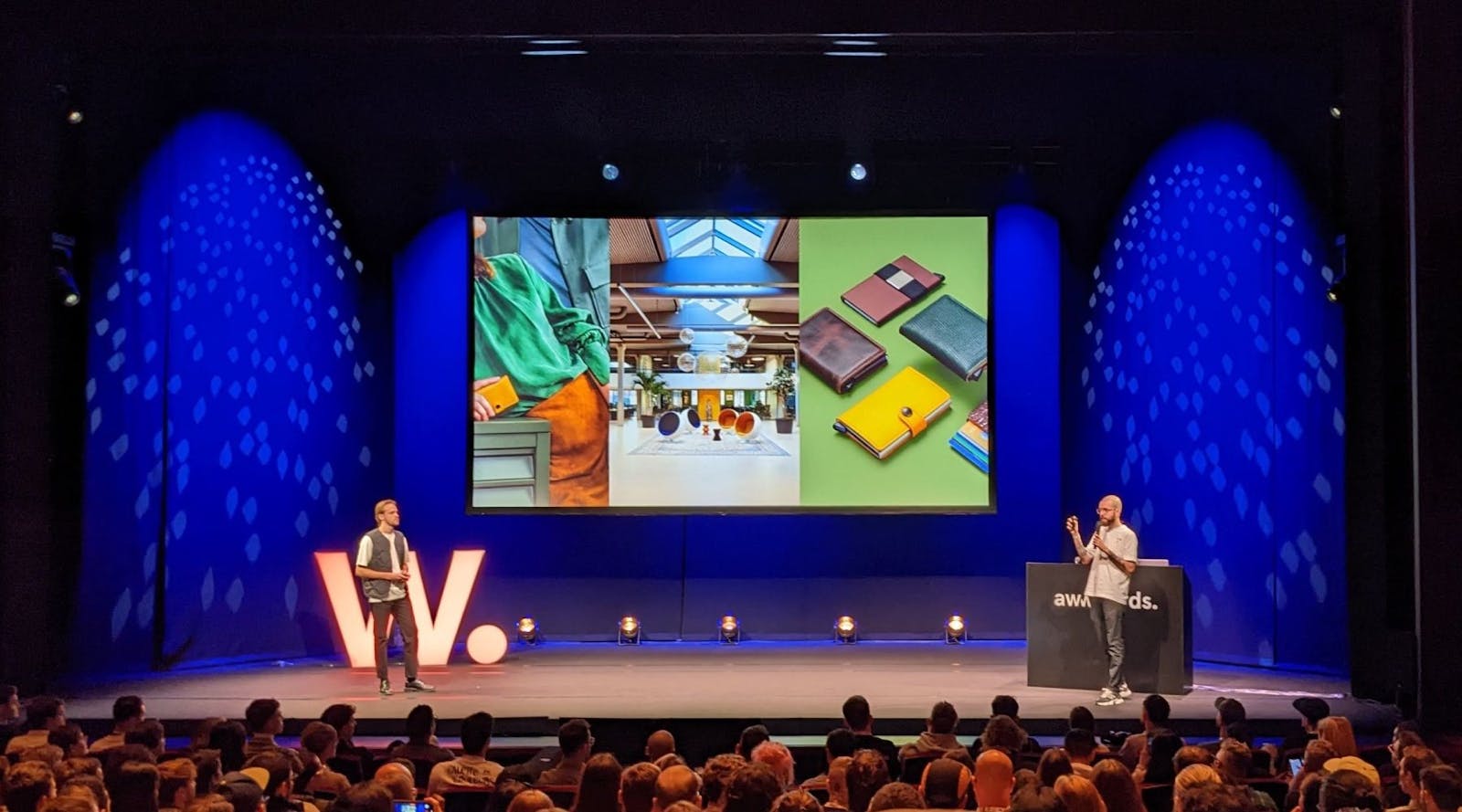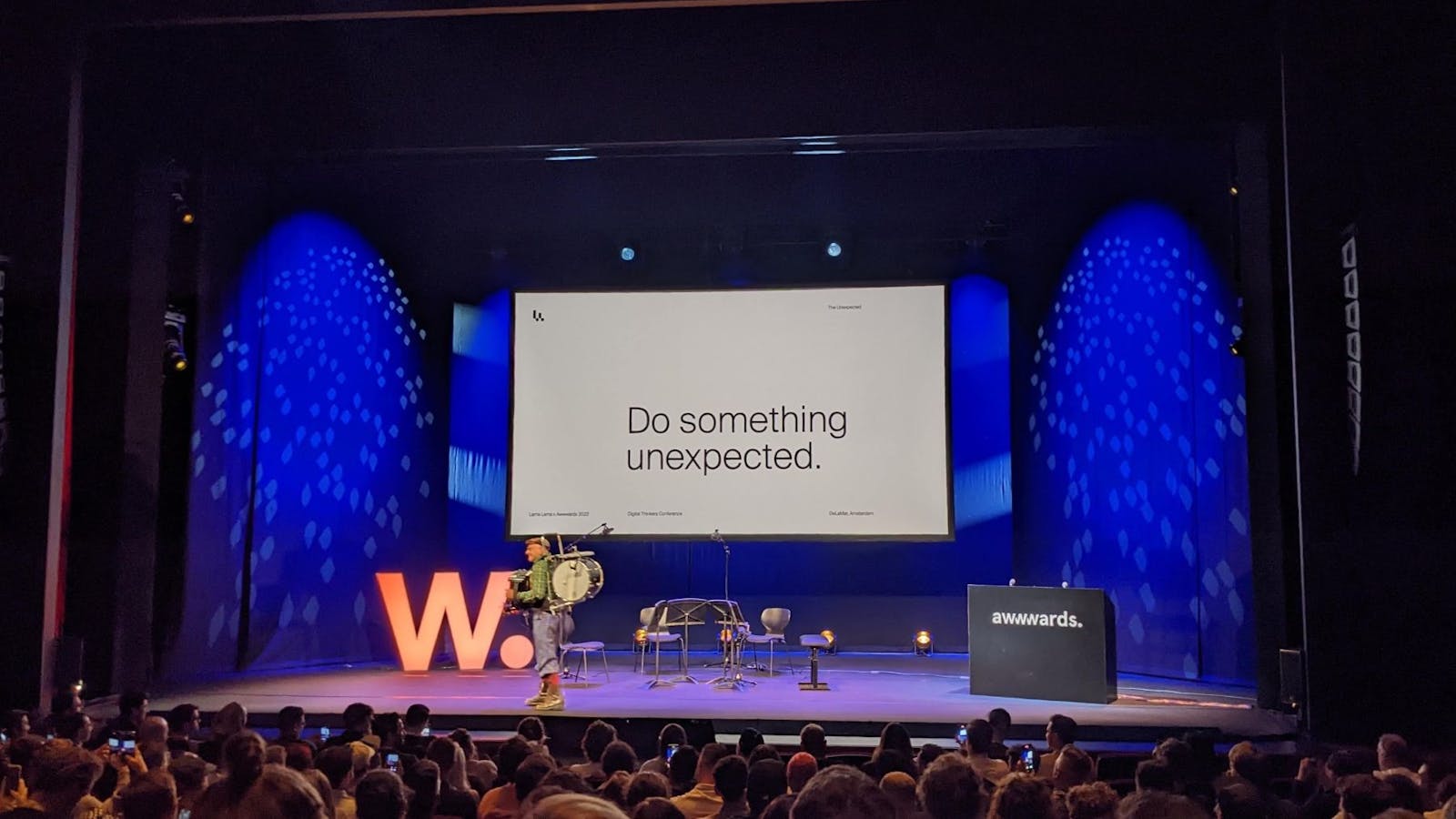The Awwwards Conference 2022 - 3 topics you really need to know about
Blog
The Awwwards Conference took place in Amsterdam on Thursday 15 and Friday 16 September. Naturally, Harborn’s UX designers Lisanne & Riska were there. They listed the most important developments and insights to keep you informed!
When the Awwwards Conference returned to Amsterdam after 2.5 years, we knew we had to be there! For two days, we immersed ourselves in the world of user experience, creativity and online innovation. We attended over twenty lectures by the most progressive designers and enjoyed the abundance of inspiration, funny gifs, and unexpected musicians. But, we naturally also looked at what we can do with all that information! That’s why we have summarized our three most important topics below for you, including our own modest Harborn vision…
Do you go for animation, functionality, or both?
It was a huge topic this year: animation. Colourful, moving, interactive 2D or 3D-elements that are taking the web by storm. The use of ‘motion’ on websites or in applications can surprise users, enliven a webpage or app, or help convey information. Where Adobe and others blew us away with impressive, sometimes rather overwhelming creations, Louis Plaquet pointed out the art of a measured approach. For example, a small moving element can easily shift the user's attention. We also know that animation does not always benefit user-friendliness and that 3D-renders are not equally suited to every device. Anais Iris posed the honest question of whether 3D-animation actually has a place in a world in which accessibility, inclusivity and sustainability play an increasingly important role. Sofia Papadopoulou and Teyosh actually see endless possibilities. They gave us an inspirational glimpse of the future with their ‘Metamodernism’ -a reference to the Metaverse- and ‘Dictionary of online behaviour’.
“Creating the future we are excited about.”

Our vision
At Harborn, we see that (micro) animation is a latent need of many end users. It feels like the (new) basic standard for both B2C and B2B products. And that is completely understandable: animations and transitions can be extremely handy in guiding users through a product. They offer help with onboarding or with the explanation of certain functions. And what about putting a small movement in the call to action to shift the user's attention? Or managing their expectations by showing a loader? Numerous options that make a digital product so much more user-friendly! And not just retail sites, but B2B products too. For example, portals in which a great deal of information comes together and where oversight and hierarchy are extremely important. Although the need is not always recognised, a product without these animations and transitions soon feels angular, rough, and even awkward. We use animation for B2C as well. But, we like to use it thoughtfully and well-considered, so it genuinely adds value.

Design, development and the gap that needs to be bridged
Or: How To Make Love, Correctly, as Jerrie (design) & Bruno (development) refer to it. It was a widely discussed topic at the conference, which indicates that the ‘handoff’, as we refer to the handover from design to development, is anything but seamless for many companies. Jerrie and Bruno gave us a checklist. It says that UX designers must put all artboards on the same page, that ‘Type’ and ‘Colours’ must be created as style, and that we may not use half-pixels. It is familiar and amusing, although we of course know better. Furthermore, directions and notes for development are very important and we must involve developers in the process at an early stage. The insight we gained into the process and the design system used by booking.com proved to be very informative in that respect.
Most important take-aways
- Involve development in the process early on
- Keep communicating with one another
- Directions for development are a must
Our vision
Designers and developers work together closely at Harborn. Developers are involved at an early stage via Figma. They can offer comments proactively and have rights to export. Both design and development are involved in completing the user stories (Short descriptions of a desired functionality, described in the language of the user, ed.) and work together to achieve a good end result. Delivering a good product is a team effort. And ultimately, developers and designers have the same goal: to add as much value as possible for the client. As long as we keep that in mind, we can certainly discuss that checklist ;).

Design makes an impact
Sometimes you just need to be reminded of that. Mikkel Noe Westh's wonderful story about the site he built for the Third Strike Campaign made us realise what an impact a product can have. The incredible duo of Cabeza Potata, who are involved in character design for Spotify, amongst others, underscored the importance of fun. Setting healthy boundaries to preserve the fun is, according to them, part of that. They learned to say ‘no’ so they could remain true to themselves. They made time to create characters offline too, like large funny dolls or a chess game. Simply because it is fun and because it reinforces their love of the craft. That fun and passion translates into their online communications in an incredible way and underscores that aesthetics can make a huge impact. Alice Cappo adds that this impact also brings responsibility with it. It encourages us to make genuine, conscious choices in terms of accessibility and inclusivity.
“Make something that people want” vs “Making people want something”
That all starts with recognising exclusion and engaging in discussion. With testing with real people and allowing them to say what they think of it. With giving, instead of taking. And there is still a lot of work to do on that. The good news is that organisations in the top quartile for ethnic/cultural diversity of executives are 36% more likely to have above average profitability. Let that be a motivation! Finally, Irene Perreyra challenged us to remain critical of design principles. Know when you need to break with convention. 'Usability first’ is what we were always taught. However, more and more research is showing that the more attractive an IT product, the more concessions users make in terms of accessibility and user-friendliness. It is precisely the doing it ‘differently’ that is important for keeping the web fun and appealing.
Our vision
User-friendliness, accessibility and inclusivity are always top of mind for us as UX designers. Harborn strives to produce experiences that are accessible to as many people as possible. Now that WCAG (Guidelines for accessibility, ed.) is mandatory for E-commerce and governments, this realisation is slowly filtering through to the market. And that is good, because then we can really make a difference.

A glimpse into the future
Now that you are completely up to date, we still have a short list we would like to share with you. In addition to having gained tons of inspiration, the Awwwards challenged us on the following levels:
The Metaverse
We are already in it! Harborn is doing more and more projects in the field of Augmented and Virtual Reality. Storytelling is increasingly shifting to Storyliving, with interactivity playing a big role.
Sensory Design
Sensory Design is synonymous with interactivity. After all, the more senses you stimulate, the more realistic a ‘metaverse’ experience becomes. What are the possibilities of sound, for instance? Smell was also mentioned. An interesting option, because of all our senses, smell is most strongly related to our memories…
The future of the web?
It is a new era for the web, that much is clear. Stefan Sagmeister even asserts: ”everything that involves reality is up for discussion.” And we are happy to have that discussion!
Lisanne
Are you as inspired as we are?
Or do you like a good discussion about stimulating, progressive or innovative ideas? Please contact us, because we are always looking forward to a great project!